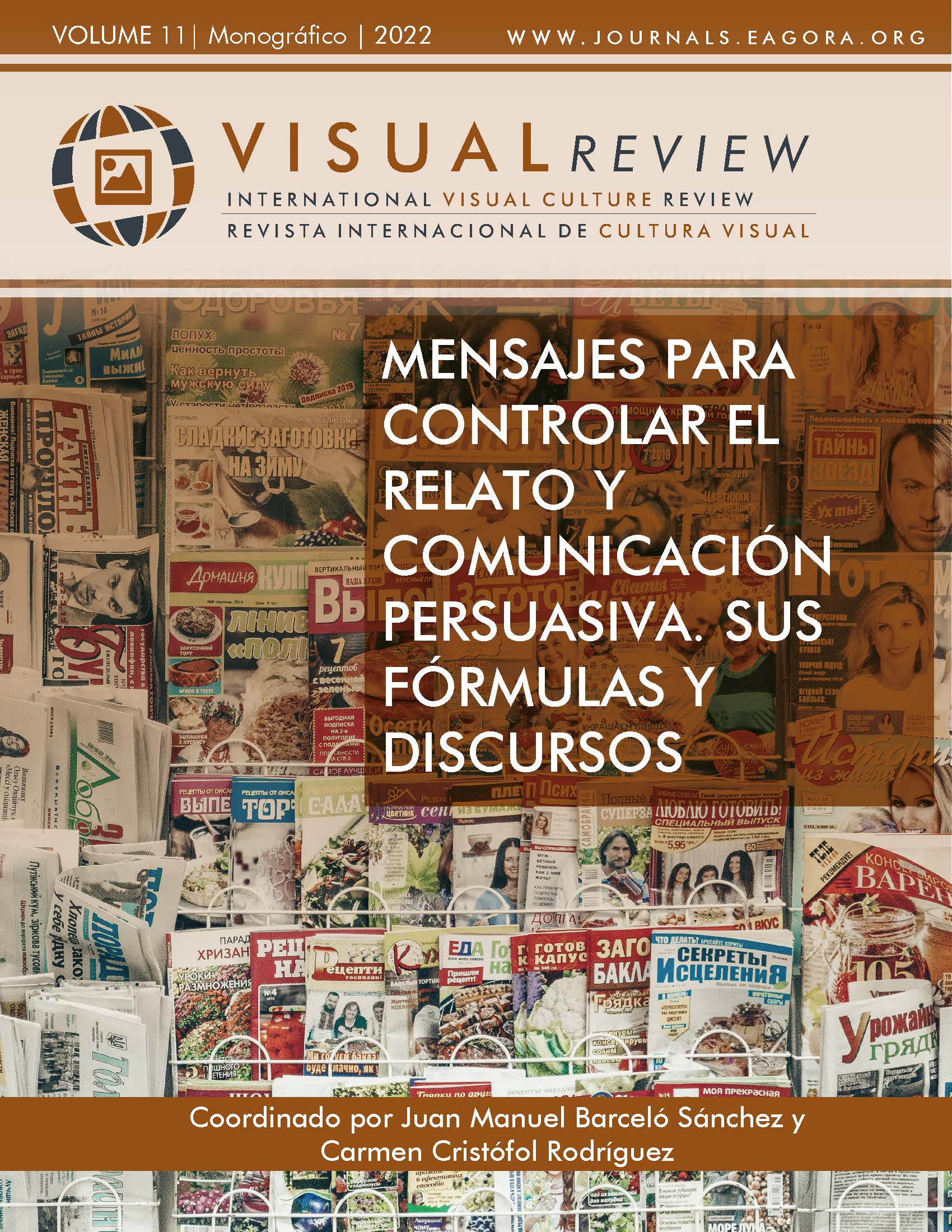Multimodal narratives about death in the children’s picture book: typologies and most frequent resources
DOI:
https://doi.org/10.37467/revvisual.v9.3653Keywords:
Picture book, Death, Childhood, Memory, Multimodal narrationAbstract
Current children's picture books that focus on death are studied, considering these publications a fundamental resource to create necessary dialogues with childhood. After analyzing a sample of ten picture books following a qualitative methodology, three typologies are extracted: albums that show the importance of memory for healing after loss, those that focus on the acceptance of death as something nat- ural, and those that claim the memory of ancestors. The predominance of picture books about the relationships between grandchildren and a grandparent who ends up dying, shows the scarcity of other less dramatic perspectives.
Downloads
Global Statistics ℹ️
|
857
Views
|
584
Downloads
|
|
1441
Total
|
|
References
Arnal, J. I. (2011). El tratamiento de la muerte en el álbum infantil. Obras publicadas en castellano (1980-2008). (Tesis doctoral). Universidad del País Vasco. Repositorio Institucional ADDI. https://addi.ehu.es/ bitstream/handle/10810/7663/ARNAL%20GIL.pdf?sequence=13
Azancot, N. (2016, 8 de diciembre). No es un juego de niños. Hablan los editores: Xosé Ballesteros y Rocío de Isasa.
El Cultural, El Español. https://bit.ly/3yQUmbi
Bley, A. (2017). ¿Qué viene después de mil? Takatuka (primera edición en español en 2009). Di Nola, A. M. (2007). La muerte derrotada. Antropología de la muerte y del duelo. Belacqua. Erlbruch, W. (2007). El pato y la muerte. Barbara Fiore.
Hidalgo, M. C. (2015). The Interaction between Text and Image in Picture Books. Analysis of Story Books Published in Spain Today. The International Journal of Visual Design, 9(3), 1-14. https://doi.org/10.18848/2325- 1581/CGP/v09i03/38741 DOI: https://doi.org/10.18848/2325-1581/CGP/v09i03/38741
Hidalgo, M. C. (2022). El contrapunto en el álbum ilustrado infantil. Un análisis multimodal para su implementación en la asignatura Ilustración Infantil del Máster de Dibujo (Universidad de Granada). Revista KEPES, 19(25), 427-462. https://doi.org/10.17151/kepes.2022.19.25.15 DOI: https://doi.org/10.17151/kepes.2022.19.25.15
Hidalgo, M. C., Blancas, S. & Alonso, C. (2018). Ilustrar para todos. Álbumes ilustrados sobre diversidad e igualdad.
Illustrating for Everyone. Picture Books about Diversity and Equality. Universidad de Granada.
Martínez-Barragán, C.(2011). Metodología cualitativa aplicada a las Bellas Artes. Revista Electrónica de Investigación, Docencia y Creatividad, 1, 46-62. https://dialnet.unirioja.es/servlet/articulo?codigo=4060381
McKee, D. (2005). Odio a mi osito de peluche. I Hate My Teddy Bear. Anaya.
Meyer, S. E. (1997). A Treasury of the Great Children’s Book Illustrators. Harry N. Abrams, Inc. Pub. Meek, M. (1988). How Teach What Readers Learn. Thimble Press.
Montoya, V. (2007). El dilema de la muerte y la literatura infantil. Primeras Noticias. Revista de literatura, 231, 21-
http://www.centrocp.com/el-dilema-de-la-muerte-y-la-literatura-infantil/
Nikolajeva, M. & Scott, C. (2000). The Dynamics of Picturebook Communication. Children’s Literature in Education, 31(4), 225-239. DOI: https://doi.org/10.1023/A:1026426902123
Nikolajeva, M. & Scott, C. (2006). How Picturebooks Work. Routledge.
Nodelman, P. (1988). Words about Pictures: The Narrative Art of Children’s Picture Books. The University of Georgia Press.
Nogués, A. (escritor) & Guridi (ilustrador) (2018). Parco. Akiara.
Parera, N. (escritora) & Suárez, A. (ilustradora) (2015). Mi abuelo y yo. Juventud.
Parmeggiani, R. (escritor) & Vaz de Carvalho, J. (ilustrador) (2015). La abuela durmiente. Kalandraka. (primera edición en 2014).
Pregl, S. (escritora) & Lubi, M. (ilustradora) (2017). Te has ido, pero sigues estando aquí. Picarona (primera edición en 2016).
Ramón, E. (escritora) & Osuna, R. (ilustradora) (2020) ¡No es fácil, pequeña ardilla! Kalandraka (primera edición en 2003).
Salisbury, M. & Styles, M. (2012). El arte de ilustrar libros infantiles. Concepto y práctica de la narración visual.
Blume.
Silva-Díaz, M. C. (2005). Libros que enseñan a leer: álbumes metaficcionales y conocimiento literario (Tesis doctoral). Universidad Autónoma de Barcelona, España. Repositorio Institucional UAB. https://www.tesisenred. net/handle/10803/4667?locale-attribute=es#page=1
Strausfeld, M. (1989). El realismo crítico en la literatura infantil-juvenil. CLIJ: Cuadernos de literatura infantil y juvenil, 83, 83-87.
Teckentrup, B. (2021). El árbol de los recuerdos. Nube Ocho Ediciones y Pepa Monano Editora (primera edición en español en 2013).
Toro, G. (escritor) & Ferrer, I. (ilustrador) (2007). Una casa para el abuelo. Sins Entido.
Turín, A. (1995). Los cuentos siguen contando. Algunas reflexiones sobre los estereotipos. Horas y Horas. Van der Linden, S. (2015). Álbum[es]. Ekaré.
Van Hest, P. (escritor) & De Bruyn, S. (ilustrador) (2017). En todas partes y en cualquier lugar. Urano.
Whalley J. I. & Chester, T. R. (1988). A History of Children’s Book Illustration. John Murray with the Victoria & Albert.
Downloads
Published
How to Cite
Issue
Section
License
Those authors who publish in this journal accept the following terms:
-
Authors retain copyright.
-
Authors transfer to the journal the right of first publication. The journal also owns the publishing rights.
-
All published contents are governed by an Attribution-NoDerivatives 4.0 International License.
Access the informative version and legal text of the license. By virtue of this, third parties are allowed to use what is published as long as they mention the authorship of the work and the first publication in this journal. If you transform the material, you may not distribute the modified work. -
Authors may make other independent and additional contractual arrangements for non-exclusive distribution of the version of the article published in this journal (e.g., inclusion in an institutional repository or publication in a book) as long as they clearly indicate that the work was first published in this journal.
- Authors are allowed and recommended to publish their work on the Internet (for example on institutional and personal websites), following the publication of, and referencing the journal, as this could lead to constructive exchanges and a more extensive and quick circulation of published works (see The Effect of Open Access).













